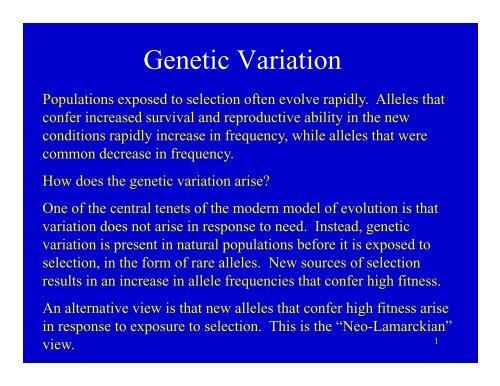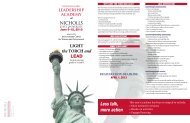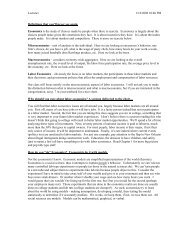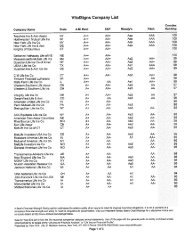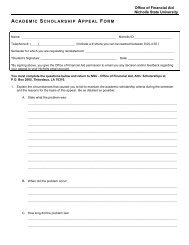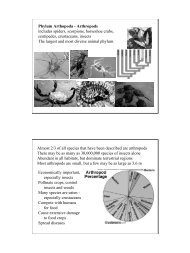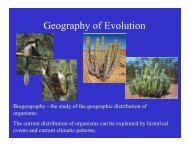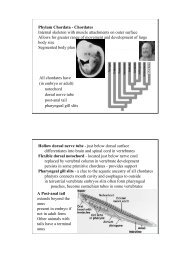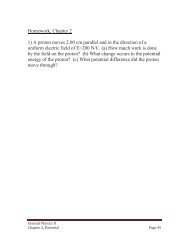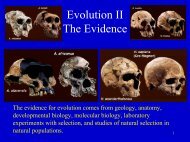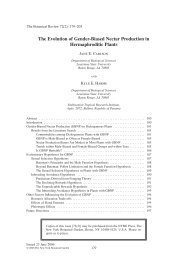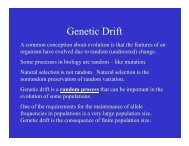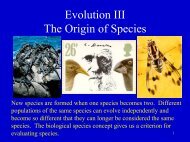Genetic Variation.pdf - Nicholls State University
Genetic Variation.pdf - Nicholls State University
Genetic Variation.pdf - Nicholls State University
- No tags were found...
You also want an ePaper? Increase the reach of your titles
YUMPU automatically turns print PDFs into web optimized ePapers that Google loves.
<strong>Genetic</strong> <strong>Variation</strong>Populations exposed to selection often evolve rapidly. Alleles thatconfer increased survival and reproductive ability in the newconditions rapidly increase in frequency, while alleles that werecommon decrease in frequency.How does the genetic variation arise?One of the central tenets of the modern model of evolution is thatvariation does not arise in response to need. Instead, geneticvariation is present in natural populations before it is exposed toselection, in the form of rare alleles. New sources of selectionresults in an increase in allele frequencies that confer high fitness.An alternative view is that new alleles that confer high fitness arisein response to exposure to selection. This is the “Neo-Lamarckian”1view.
Two different experiments with bacteria originally provided evidencethat variation does not arise in response to need.Luria and Delbruck looked at variation among bacteria for resistance toa phage. They reasoned that if variation arises in response to need, theincidence of new resistance in cultures of originally nonresistant bacteriashould not vary greatly among independent cultures.They started multiple cultures of nonresistant bacteria, allowed them tomultiply, and then exposed the bacteria to phage to test for resistance.Under the hypothesis that variation arises in response to need, theywould expect all variation to arise after exposure. As a result they’dexpect little variation in the number of resistant colonies among cultures.Their expectation:2
Under the hypothesis that variation arises randomly, not inresponse to need, resistance could appear in any generation, andthus some cultures would have many resistant bacteria (as a resultof early mutation) and some cultures would have none (as resultof no mutation). They expected great variation in the number ofresistant colonies among cultures:This is what Luria and Delbruck found.3
In the second experiment, Joshua and Esther Lederberg usedreplica plating to determine if penicillin resistance in bacterialcolonies was present before exposure to penicillin or only aroseafter exposure to penicillin. They cultured nonresistant bacteriaand then exposed them to penicillin. Their technique allowed themto determine if the original colonies from which the resistantbacteria were derived were resistant before exposure to penicillin.Their results showedthat resistance did notarise during exposureto penicillin.Resistance arose inthe culture beforeexposure topenicillin.4
Mutation - the alteration of a region of DNA or chromosome;and altered state of a region of DNA or chromosomeTypes of mutations:base pair substitution - a single base pair change in DNA, alsocalled a point mutationPoint mutationscan result insingle aminoacid changes(nonsynonymousmutation)or no change inamino acid –(synonymousmutation)5
Nonsynonymous mutations may have small or large effects on theproperties of the protein product of the gene.A single base pair addition or deletion is a frameshift mutation -the result is a change in reading frame of RNA product of the geneand many amino acid changes in the protein product - usuallyresults in a nonfunctional protein product.6
Recombination can also result in sequence changesIntragenic recombinationOriginal Sequence: ATTGATCGATCTATGCTAACTAGCTAGATACGMutation Sequence 1: ATGGATCGATCTATGCTACCTAGCTAGATACGMutation Sequence 2: ATTGATCGATGGATGCTAACTAGCTACCTACGRecombination ATGGATCGATGGATGCSequence TACCTAGCTACCTACGThe amino acid changes resulting from the original two pointmutations are combined in a single protein as a result ofrecombination.7
Unequal crossing-over results in sequence duplications and deletions.Unequal crossing-over usually occurs in regions where there aretandem repeats.The result can be a reduction in the number of repeats or an increasein the number of repeats.High numbers of tandem repeats make a region liable to unequalcrossing-over and additional duplications.It can give rise to gene families (multiple copies of variants of a singlegene) and new functional genes.8
Transposable elements - sequences of DNA that can be insertedinto regions of the genomeInsertion of a sequence of bases into a functional gene or theregulatory region of a functional gene can destroy normalfunctioning of that gene.Transposable elements can result in the movement of neighboringgenes that were not initially i i part of the transposable elements.Recombination betweentransposable elementscan result in deletions orinversions of base pairsequences.9
Examples of mutations:Sickle-cell anemia - a single base pair substitution that results in asingle amino acid change in the β chain of HbPrecocious puberty - a single amino acid change in the gene for thereceptor for luteinizing hormone results in males that show signs ofpuberty as early as age 4.Cystic fibrosis - a fatal disease that occurs in 1 in every 2500 birthsamong northern Europeans is due to a mutation in a chloride ionchannel protein. Different mutations account for the same condition:a deletion of 3 base pairs results in the deletion of a single aminoacid, a conversion of an arginine codon into a stop codon, analteration in a splicing enzyme has resulted in the deletion of an exonfrom the mRNA transcribed from the gene.10Retinitis pigmentosa - a degenerative disease of the retina - can becaused by mutations in at least 8 different genes.
Hemophilia - caused by mutations in two different genes forblood clotting proteins. The mutations can be base pairsubstitutions, small deletions, small duplications. Twenty percentof the cases of hemophilia A are caused by an inversion of a longsequence of bases within one of the genes.Huntington’s disease - a fatal neurological disorder - is due to anexcessive number of repeats of the sequence CAG - normal formsof the genes have 10 to 30 repeats, mutants have more than 75Although most mutations are have deleterious effects on theencoded protein some have beneficial effects and have beenimportant in evolution11
FOXP2 - encodes a transcription factor - mutations in this genecan cause severe speech and dlanguage disorders. d Humans differfrom chimpanzees at two base pairs that result in nonsynonymousamino acid changes. The amount of change in this gene isunusually high relative to synonymous changes in the genesuggesting the gene may have been important in the evolution ofhuman speech abilities.12
Estimating Mutation RatesMutation rates can be estimated by theirappearance in laboratory stocks or bycounting the number of offspring bornin each generation with genetic diseasecaused by a dominant allele - these arelikely to be underestimates of thefrequency of point mutations becausesynonymous mutations result in thesame phenotype as nonmutants.Mutation ti rates can be estimated t indirectly by counting the numberof differences between two descendants of a common ancestor andcounting the number of generations since their origin. This methodassumes that no selection has been involved in the change in allelefrequency with each species.13
Mutation rates can be estimated by assuming that deleteriousmutations are removed by selection.The forward mutation rate (A a) is given the symbol μ.The reverse mutation rate (a A) is given the symbol ν.μA aνWithout mutation, deleterious dominant alleles should beremoved by selection until they are absent from thepopulation. pp So the mutation rate is equal to the observedfrequency of the deleterious dominant alleles (p) in thepopulation.ν = p14
Deleterious recessive mutations will be removed fromthe population very slowly once they become rare.The rate of removal is2spqAnd, when the recessiveΔ p =21 − sqallele is rare thedenominator is ~1.p = f(A),q = f(a)Deleterious recessive alleles are reintroduced by mutation at rateμp So, in a population in which mutation adds the allele andselection removes it we should haveμ p =spq2μ =2sqIf the deleterious recessive allele is lethal(s=1), the mutation rate is equal theobserved frequency of homozygotes.15
Rates of mutation of individual base pairs are low but whensummed over the entire genome the effect is considerable.With 1.6 mutations per sexual generation in the effective genome, apopulation of 1 million humans will have 1.6 million newmutations in each generation. Although most will be deleterious orneutral, if only a small fraction were beneficial there would beconsiderable raw material for evolution.16
Mutations and FitnessMost mutations have little or no effecton fitness. A few are beneficial and afew are very deleterious.17
The effects of a mutation can vary among environments.An allele that increases fitness in a cool environment may decreasefitness in a warm environment.The sickle-cell allele confers high fitness to the heterozygote wheremalaria is common but is neutral in heterozygotes where malaria isnot common.Experiments with Drosophila showed that a mildly deleteriousallele became up to 10 times more deleterious when populationspwere crowded and had fewer resources.Thus, many alleles that have little or no effect on fitness in thecurrent environment may be beneficial or harmful if theenvironment changes. For example, alleles for pesticide orantibiotic resistance may have little effect on fitness until the agentis applied. The same is likely true for many other mutations.18
The effects of slightly beneficial mutations in different genes can becombined to produce more adaptive combinations.iDDT resistanceMutations in differentindividuals can becombined quickly in sexualspecies.In asexual speciescombination of mutationsdepends d upon multiplelindependent mutationswithin a genetic lineage.Sex allows much fasteradaptation through the rapidcombination of slightlybeneficial mutations. 19
Changes in KarotypeKaryotype - a description i of the chromosomal constitution i ofand organism - number, size, shape, internal arrangementChanges in ploidy - the number of sets of chromosomesAneuploidy - loss or gain of one or more chromosomes in a set -this is usually deleterious because of genic imbalance- DownSyndrome in humans is the result of 3 copies of chromosome 21 -trisomy 21Polyploidy - having one or more extra sets of chromosomes2N - diploid, 3N - triploid, 4N - tetraploid, etc.Polyploid organisms can have problems with meiosis.An autopolyploid has multiple sets of chromosomes from thesame species. An allopolyploid has multiple sets ofchromosomes from different species.20
An odd number of eachset of chromosomesresults in problems withsynapsis andsegregation.Many of the resultingcells receive anunbalanced (aneuploid)set of chromosomes.Aneuploid gametesproduce aneuploidzygotes that usuallyhave problems becauseof genic imbalance.21
Autopolyploids witheven numbers ofchromosomes canalso produceaneuploid gametes.22
Hybrid organisms receive two different sets of chromosomes, onefrom each parent species. They are usually sterile becausedifferences in gene arrangements among chromosomes results inimproper synapsis and aneuploid gametes.Duplication ofwhole sets ofchromosomes(allopolypoidy)may result ingametes thathave balancedsets ofchromosomes.23
Allopolyploids with a diploid number of sets of chromosomesfrom each parent (2N A +2N B ) produce gametes that are euploidwith one set of chromosomes from each parent (N A + N B ).Such organisms are potentially interfertile or self-fertile but theycan’t produce fertile offspring in backcrosses with either parentspecies.Gamete (N A + N B ) combined with gamete (N A ) produces anallotriploid (2N A + N B ) that produces unbalanced sets of genes ingametes.Thus, allopolyploids are reproductively isolated from each oftheir parent species. They can only reproduce with otherallopolyploids or through self-fertilization. They are new speciesas soon as they are formed.Many species of plants and some animals are polyploid. At least50% of all flowering plants are polyploid.24
Chromosome rearrangementsBreakage and reunion of chromosomes can change gene order orchange the distribution of genes among chromosomes. Suchchanges generally have little or no effect on the phenotype of theorganism. Some rearrangements can have effects on the frequencyof recombination and fertility.An inversion of gene order: ABCDEFG ABEDCFGresults in a looparrangement in thechromosomes duringsynapsis25
A paracentric inversion is an inversion ofa portion of a chromosome that does notinclude the centromere.In a heterozygote, synapsis of the geneswithin the inversion is only possible if oneof the homologs forms a loop.Cross-overs can occur within ihi theinversion, but the chromatids involved inthe cross-over will be geneticallyimbalanced and either be dicentric oracentric. They will have problems duringsegregation and the gametes that receivethem will not be viable.Only the non-recombinant chromatids willproduce viable gametes - thus preserving26the original gene combinations.
A pericentric inversion is an inversion ofa portion of a chromosome that includesthe centromere.In a heterozygote, synapsis of the geneswithin the inversion is only possible ifone of the homologs forms a loop.Cross-overs can occur within ihi theinversion, but the chromatids involved inthe cross-over will be geneticallyimbalanced. They will have problemsduring segregation and the gametes thatreceive them will not be viable.Only the non-recombinant chromatidswill produce viable gametes es -thuspreserving the original gene27combinations.
A translocation is a movement of genesfrom one chromosome to another.Reciprocal translocations involve a swap ofgenes between two chromosomes.A heterozygote for a reciprocaltranslocation is genetically balanced andviable, but during gamete productionsynapsis of the chromosomes produces across-shaped pattern.28
At anaphase centromeres are pulled to oppositepoles. There are three possible ways thecentromeres can associate - alternate, t adjacent-1,and adjacent-2.Only alternate segregation will result in geneticallybalanced gametes.Thus, the only viable gametes from a translocationheterozygote will have chromosomes identical ingenetic constitution to the sets received from itsparents.Thus, translocation heterozygotes will not exhibitindependent assortment of these pairs ofchromosomes. This also preserves genecombinations.Translocation heterozygotes are partially sterile andthis may form the basis for partial post-zygoticisolation between closely related species. 29
Chromosome number canchange through fission orfusion of chromosomes orpieces of chromosomes.30
Karyotypicypchanges throughfission and fusioncan be dramatic.Such changes canbe the cause ofreproductiveisolation betweenrelated ltdspecies.31
The karyotypes ofprimates differ bygene rearrangementswithin chromosomes(as shown bybanding patterns)and difference inchromosome numberdue to fusion orfission ofchromosomes.32


